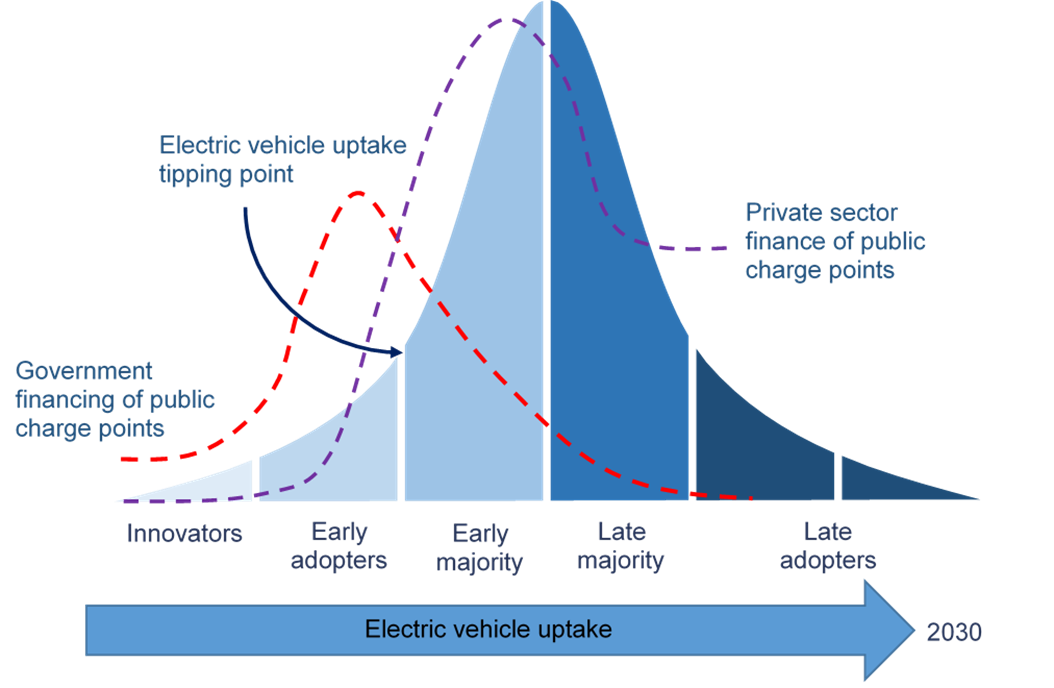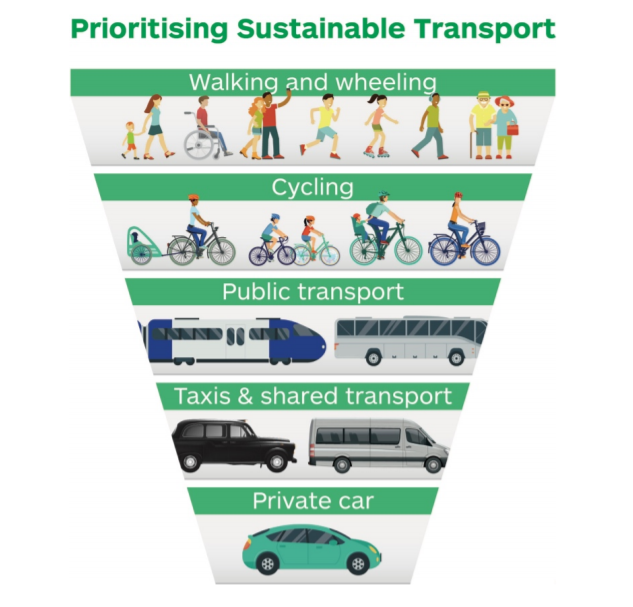3. Making this vision real – outcomes and priorities
The world of electric vehicles and charging is undergoing a significant period of innovation and change. As such, this is purposely a draft strategic vision; underpinned by a number of outcomes and priority areas of focus. It is our intention to engage with users and key parts of the market to refine the vision. Activity is also already underway that is aligned with the vision, such as on-going work on establishing requirements for electric vehicle charge points and enabling infrastructure in new build homes and, non-domestic publicly accessible premises, which the Scottish Government consulted upon in 2021.
3.1 A people-focused network
Ultimately, households and businesses need to be front and centre of the planning and delivery of public charging infrastructure. This applies not only to today’s public network but also to tomorrow’s. A new generation of infrastructure and service delivery models will need to be considered as older technologies become obsolete and as expectations of access to a high quality, affordable and reliable service continues to grow.
It will be important that users of the network are fully engaged to shape its development and to ensure that its inclusive design caters for everyone’s needs – reflecting that a one-size-fits-all approach is unlikely to deliver optimal outcomes. There are clear opportunities to create models of best practice, set out established and robust national guidelines which could be aligned with similar activity across the UK. Their implementation in the public charging network could be facilitated through a number of avenues including public procurement. The approach will also need to consider the wider community too to avoid, for example, designing public electric vehicle infrastructure that impedes pedestrians access to pavements and their ability to move around freely.
Outcome we want to achieve
- People have access to a well-designed and comprehensive public network of charge points
- The public electric vehicle network works for everyone regardless of age, health, income or other needs
Priorities
- Drawing on feedback from community engagement to continuously improve Scotland’s public charging network; through consultation, surveys and other engagement
- Working with the design community and industry to make charging an electric vehicle simple and seamless; tackling issues relating to charge point design for the benefit of all groups of users to ensure a Just Transition
- Enabling investment in public electric vehicle charge points to support communities that don’t have access to home charging; ensuring convenient access and at a fair cost
3.2 Accelerating commercial investment
Like many new technologies, the uptake of electric vehicles will be characterised by different categories of adopters across society. For plug-in electric cars, Scotland is moving towards a tipping point that is seeing a shift from an innovator and early adopter phase to an early majority phase. As adoption of electric vehicles continue to increase, this will influence the development of the public charging network along with the role and nature of government intervention.

We can expect a shift towards a public charging network largely financed and operated by the commercial sector. Whilst this is central to our Vision we are not at that point yet. Nor will there be a uniform approach across Scotland to get there. At this stage of the market’s development, public and private sector partnerships will be a key enabler in attracting and making the commercial case for investment viable. The public sector will continue to play an important role in the transition, but the nature of its support will not remain static and it will change over time to meet the needs of different consumers and distinct geographies of Scotland, where, on its own, the market is unable to deliver at the scale and pace required.
Although difficult to precisely define, expanding the public electric vehicle charging network between now and 2030 could need up to £1 billion investment. This environment creates considerable opportunities to attract a range of service providers and private capital in Scotland. In doing so, it has the potential to leverage the skills and expertise of Scotland’s world-class academic base as exemplified for example through the Michelin Scotland Innovation Parc in Dundee and Power Networks Demonstration Centre in Cumbernauld. Furthermore developing Scotland’s public network and accelerating commercial investment will enable supply chain and service sector growth and anchor well paid and high quality green jobs across Scotland.
Outcome we want to achieve
Scotland has attracted private sector investment to grow the electric vehicle charging network, ensuring it meets the needs of all people.
Priorities
- Working with investors, charge point network operators and other parties to provide access to ChargePlace Scotland data; creating an enabling environment to support investment in public charge points
- Enabling new models of public electric vehicle charge point financing and delivery, focused on public and private partnerships, to support and coordinate investment
- Ensuring public funds are targeted at areas where commercial investment is unable to fully deliver; using public procurement to deliver an affordable, reliable and well-maintained network of charge points across Scotland
- Working with Scotland’s enterprise and skills agencies to realise supply chain opportunities from electric vehicles and infrastructure in Scotland
3.3 Coordinating with the electricity network
Treating public electric vehicle charging infrastructure in isolation to the wider energy system is unlikely to deliver optimal outcomes. Whilst growth in the number of electric vehicles may pose challenges for planning and operating of Scotland’s electricity networks, it also provides opportunities. The storage potential of electric vehicle batteries, for example, provides a vast distributed source of energy to help manage the demands of a modern, responsive and efficient electricity network. A robust and comprehensive public electric vehicle charging network will underpin this; offering the ability to support the needs of vulnerable consumers and businesses. Scotland’s renewable electricity potential is significant, and this network should use clean, renewable energy to facilitate millions of miles of genuinely zero-emission travel. And we should not lose sight of the need to work with regulators and industry to promote and encourage end-to-end net zero, where carbon emissions are reduced across the transport process.
A ‘whole-system’ approach is needed as set out in the Scottish Government’s Scottish Energy Strategy published in 2017. Already the strength of Scotland’s approach to delivering public electric vehicle charging infrastructure has been our close, collaborative working with the energy sector, as demonstrated through the Strategic Partnership with Scotland’s electricity Distribution Network Operators which has included project PACE.

Outcome we want to achieve
The public charging network is powered by clean, renewable energy and drivers benefit from advancements in energy storage, smart tariffs and network design.
Priorities
- Continuing to work with the electricity Distribution Network Operators and Ofgem to enable a regulatory environment that delivers optimal outcomes for consumers and the decarbonisation of Scotland’s transport system
- Building on the work of the Strategic Partnership, ensure a coordinated approach is taken to planning and delivery of public electric vehicle charge points and electricity infrastructure in order to optimise investment
- Enabling Scotland to develop, test and adopt new electric vehicle and energy system technologies, drawing on the strengths of our academic institutions involving industry and consumer-focused collaboration
3.4 Integration with Scotland’s sustainable transport system
The Scottish Government’s Climate Change Plan update of December 2020 set out the ambitious commitment to reduce by 20% by 2030 the annual kilometres driven by cars. This commitment is ambitious and necessary. Not only to meet Scotland’s legally-binding targets for greenhouse gas emission reduction, but also to deliver a wider range of benefits to individuals and communities, including improvements to health and well-being.
While we know that people in some areas of Scotland and individuals with particular needs may be more dependent on car use, it is also important to recognise that a significant proportion of existing car journeys have the potential to be made in other ways. For instance through greater participation in active travel and use of public transport for journeys. It is clear, however, that if climate change targets are to be met a wholesale switch to zero-emission is required across all transport modes.

Transport Scotland’s recently published Route Map sets out the specific, evidence-based actions that need to be taken up to 2030 to support the car kilometre reduction target. This recognises not only the importance of supporting people to have the capability and opportunity to travel differently, but also the need to create the social conditions to enable motivation for change.
To align with the Route Map, it will be important to ensure that both the planning of and investment in public electric vehicle charging infrastructure is undertaken in a way that considers the wider sustainable transport system. This needs to also recognise that there will not be a one-size-fits-all approach. Whilst the 20% kilometre reduction is a national target, it does not mean that car use in rural and remote areas is expected to drop at the same rate as towns and cities. Scotland’s public electric vehicle charging network will therefore need to develop and evolve to account for local circumstances and needs.
Outcome we want to achieve
People’s first choice wherever possible is active and public transport with the location of electric vehicle charging points supporting those choices.
Priorities
- Using the Strategic Transport Projects Review 2 to inform Scottish Government investment to deliver on the vision, priorities and outcomes set out in the National Transport Strategy, reducing the need to travel unsustainably
- Enabling local authorities to plan public electric vehicle charging infrastructure – both locally and regionally; aligned with wider sustainable transport outcomes to encourage greater use of public transport and active travel
< Previous | Contents | Next >